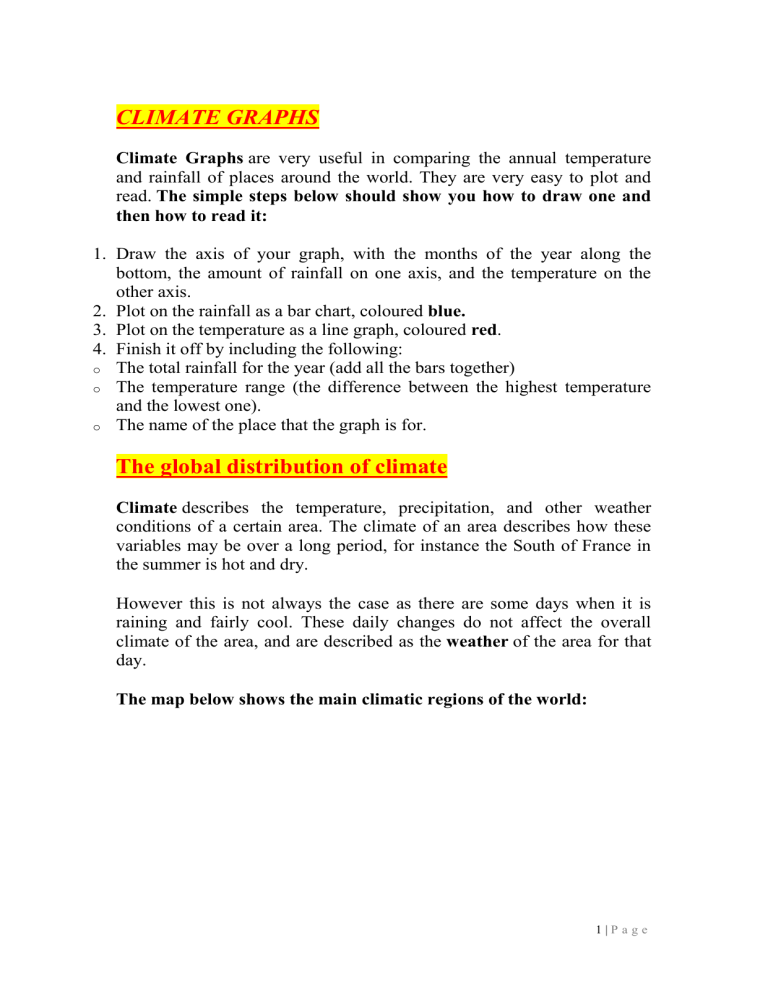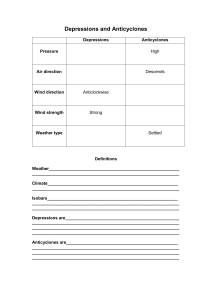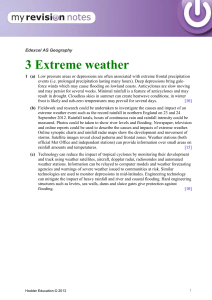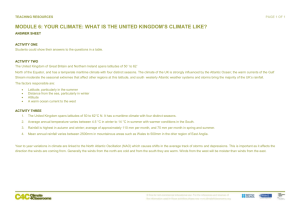
CLIMATE GRAPHS Climate Graphs are very useful in comparing the annual temperature and rainfall of places around the world. They are very easy to plot and read. The simple steps below should show you how to draw one and then how to read it: 1. Draw the axis of your graph, with the months of the year along the bottom, the amount of rainfall on one axis, and the temperature on the other axis. 2. Plot on the rainfall as a bar chart, coloured blue. 3. Plot on the temperature as a line graph, coloured red. 4. Finish it off by including the following: o The total rainfall for the year (add all the bars together) o The temperature range (the difference between the highest temperature and the lowest one). o The name of the place that the graph is for. The global distribution of climate Climate describes the temperature, precipitation, and other weather conditions of a certain area. The climate of an area describes how these variables may be over a long period, for instance the South of France in the summer is hot and dry. However this is not always the case as there are some days when it is raining and fairly cool. These daily changes do not affect the overall climate of the area, and are described as the weather of the area for that day. The map below shows the main climatic regions of the world: 1|P age Factors affecting climate Many factors affect the climate of different areas around the world. Themain ones are described below: Altitude: Temperature falls the higher youare. The loss in temperature is approximately 10°C for every kilometre yourise. This fall in temperature with height is due to the fact that the airat higher altitudes is thinner. There are fewer molecules available to receive and retain heat. Wind chill may also mean that the temperatures inupland areas are lower than expected. Aspect: This relates to the direction in which a place is facing. Aspect only really affects local climate, not global ones. In the Northern Hemisphere, south facing slopes receive far more sunlight than north facing ones. These are therefore much better for agriculture and often settlement will locate there due to the better aspect. 2|P age Distance from the Sea: The sea can have agreat influence over climates in maritime regions. The sea takes much longer to heat up but retains that heat far better than the land. Consequently the land is often warmer than the sea during the day, however the situation is reversed at night. This means that places like Britain, which are near the sea, have relatively cool days and warm nights, as well as warm summers and mild winters. The influence ofthe sea diminishes as you move further inland, for instance to central Europe, where warmer winters and cooler summers will be experienced. Latitude: on global climates. Lines of Latitude are those that run horizontally around the world. The most famous line of latitude is the Equator. Using the lines of latitude we can easily divide the world in to specific climatic sections. 3|P age Between 23.5 South and 23.5 North is the region called thetropics. These receive the most heat from the sun because itis almost directly overhead and so the solar radiation does not have to travel through very much of the atmosphere. It heats a very concentrated area of the surface of the ground. Between 23.5 and 66.5 in both the Northern and Southern Hemispheres are the temperate regions. These have reasonably hot summers and mild winters. Above 66.5 in both hemispheres are the Polar Regions, which are very cold. They receive sunlight for only half the year due to the angle of the Earth on its rotation. During the months when they do have sunlight, it travels to them at a very shallow angle, meaning that it has to travel through a lot of the atmosphere and has to heat a wide area of the surface. Ocean Currents: Many areas beside the sea are affected by ocean currents. These can be either warm or cold currents. The United Kingdom is directly in the path of the Gulf Stream and the Northern Atlantic Stream, which bring warm water from the Caribbean across the Atlantic to our shores. This current alone is the reason why our climate is mild compared to places of similar latitude like Newfoundland. Prevailing Winds: The prevailing (most common) wind in the United Kingdom comes form the South West. If a prevailing wind travels over a 4|P age warm surface it will bring warm weather, whilst if it travels over a cold surface it will bring cold weather. The south-westerly winds in Britain travel across the Atlantic. In the summer this means that the air is cooled, whilst in the winter the water warms the air, bringing warmer winters than we might expect. RAINFALL There are three common types of rainfall, all of which occur in the United Kingdom. All have the common theme of air being forced to rise. As air rises it cools it cannot hold as much moisture as it could when it was warmer. Eventually the rising air reaches a point where it is 100% saturated, in other words it cannot hold any more water. This is called dew point, and it is above this point that condensation occurs. Condensation is the process by which the water vapour (a gas) held in the air is turned back into water droplets (a liquid), which fall as rain. Convectional rainfall Very common in areas where the ground is heated by the hot sun, such as the Tropics. This is why those areas experience heavy rainfalls most afternoons. The United Kingdom does experience some convectional rainfall during the summer, particularly in the South East of the country. Convectional rainfall occurs when: The surface of the earth is heated by the sun. The warm surface heats the air above it. Hot air always rises so this newly heated air does so. As it rises the air-cools and begins to condensate. Further rising and cooling causes a large amount of condensation to occur and rain is formed. Convection tends to produce towering cumulo-nimbus clouds, which produce heavy rain and possible thunder and lightning. 5|P age Frontal rainfall The United Kingdom experiences a lot of frontal rainfall, as it is associated with the movement of depressions over the country, which are described in more detail elsewhere in this topic. Frontal rainfall occurs when: Two air masses meet, one a warm air mass and one a cold air mass. The lighter, less dense, warm air is forced to rise over the denser, cold air. This causes the warm air to cool and begin to condense. As the warm air is forced to rise further condensation occurs and rain is formed. Frontal rain produces a variety of clouds, which bring moderate to heavy rainfall. 6|P age Relief rainfall This is also called orographic rainfall, which is very common in the United Kingdom, especially on the West coast since the prevailing weather comes from that direction. Relief Rainfall occurs when: The prevailing winds pick up moisture from the sea as they travel across it, making the air moist. The moist air reaches the coast and is forced to rise over mountains and hills. This forces the air to cool and condense, forming clouds. The air continues to be forced over the mountains and so it drops its moisture as relief rain. Once over the top of the mountain the air will usually drop down the other side, warming as it does so. This means it has a greater ability to carry water moisture and so there is little rain on the far side of the mountain. This area is called the rain shadow. 7|P age DEPRESSIONS & ANTICYCLONES To understand the concept of depressions and anticyclones, we need to understand the terms atmospheric pressure, high pressure and low pressure. We all know that air exerts pressure and atmospheric pressure is nothing but the force exerted by the air on the earth. To understand properly, look at the diagram given below. Concept of depressions and anticyclones Pressure is highest at sea level and decreases with increase in altitude. Also, earth consists of various high and low-pressure areas which control the weather around the world. How low and high pressure is formed? Rising of air causes low pressure. In simple terms, the rising air leads to less air on the surface means low air particles pressure. On the contrary, if the air moves down towards the surface, it means there will be more density of air particles leading to high pressure. Easy way to remember – Taking out books from your bag (equivalent to rising of air) leads to low pressure on your shoulders while putting more books inside your bag (air towards the earth) will put high pressure on your shoulder. Just remember that low-pressure areas create rains and storms while the high-pressure area leads to clear skies. 8|P age Now that we have understood the concept of low pressure and highpressure area, it is easy to understand the phenomenon of depressions and anticyclones. Depressions The hot air tends to rise while cold air settles down. Therefore when the hot air from the land rises, it forms the area of low pressure on the earth. This area of low pressure is called Depression. The air moves from high pressure to low pressure hence the depression region get more wind circulation as compared to high pressure areas. The upward and inward circulation of wind is rapid in the low-pressure region. Depressions As the air rises from the surface and cools, it forms clouds and eventually leads to precipitation, often in the form of heavy storms. Thus, depressions are responsible for the generation of cyclones. How it affects the weather of UK? The low-pressure systems often begin in Atlantic, moving eastwards toward the UK. These are responsible for the UK’s changeable weather. In winters they form snow storms, and in summer it causes floods and heavy rainfall. Warm air migrating north from tropics meet cold dense air migrating south from the polar region. 9|P age The warm air is cut by advancing cold air, and because it has more energy and lesser density than cold air, it is forced to rise above at a cold front. Further, warm air advances into the cold air and is also forced to rise above this denser cold air at warm front. At both fronts, air is rising to lead to cooling and condensation which eventually results in the rain at both fronts. The rising air forms low pressure at the earth’s surface at the centre of the storm. Air moves in from higher pressure areas around the depression (lower pressure area) giving the high winds that we often associate with the depressions. Overall impact of depression It causes damage to the economy of the country, farming, and tourism. Disturbance in transportation. Disruption of water supply and electricity. Effect on farming leads to a price hike in supermarkets. Damage of grasslands. Drowning of small animals. Landslides Destruction of the habitat of wild animals. Interesting Fact – 2007 in the UK was the wettest since records began in 1766 caused by Atlantic depression. It leads to serious flooding in Midlands, southern England, and Yorkshire. NOTE – The pattern of the wind direction in cyclones depends on the rotation of the earth. In northern hemisphere in the conditions of low pressure or depression, the wind moves anticlockwise while the direction of the wind is clockwise in anticyclonic (high pressure) conditions. This is due to the Coriolis force of the earth or simply due to the rotation of the earth. Northern hemisphere 10 | P a g e Anticyclones Anticyclones are formed in the area of high pressure. It is formed when wind sinks towards land. The sinking of air is due to the formation of a convergence zone at a higher altitude. As the air cannot move upwards, it is forced to move downwards. As the air hit the earth’s surface, it diverges in different directions. The divergence is due to the tendency of the winds to move from the high-pressure area to low-pressure area. Due to this divergence, these winds do not carry the moisture with them to be able to form clouds. Thus, anticyclones leads to clear skies. Anticyclones How anticyclones affect the weather of UK? In winters, a stable atmosphere and light winds due to anticyclonic conditions can lead to fog and frost. The fall of temperature is due to the clear skies which allow the heat to be lost from the surface of the earth through radiation. Further, light winds encourage the formation of fog. As the sea surrounds the UK, the air is often moist. The fast cooling ground cools and condenses any moisture in the air, forming droplets of ice when the temperature falls below freezing forming frost. In summers, anticyclones bring warm, long sunny days with them. Though anticyclones make the weather dry but sometimes when the temperature get too high, it can lead to thunderstorms. Generally, anticyclones bring warm and fine weather for the UK and nearby continents. Anticyclones in winters can cause haze and fog interrupting clear vision and thus affects transportation and daily activities. 11 | P a g e




